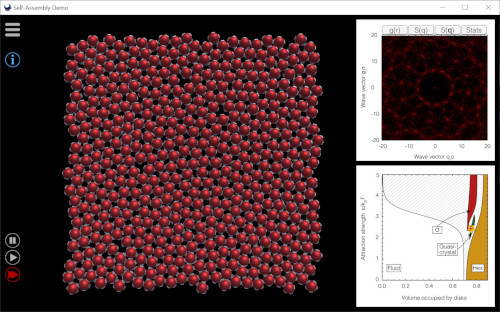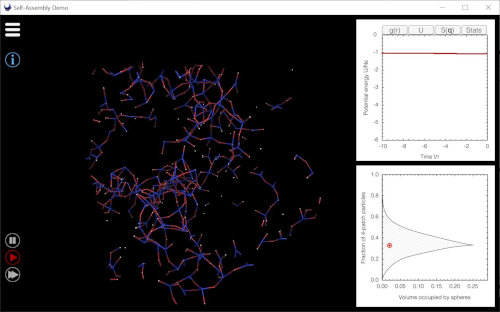Soft Matter Demos
This website is aimed at distributing interactive simulation demos that illustrate the wonderful world of soft matter physics.
Self-Assembly Demo
Version 3.1 is available now! This version includes the ability to simulate polygonal particles with custom shapes, as well as additional plotting features. Changelog
This is an interactive simulation demonstrating self-assembly: particles organizing themselves into different structures. You can use it to simulate the behavior of a box full of particles, and see how they form gases, liquids, and crystals based on the density and temperature. The included models are:
- Square-well particles (2D)
In two dimensions, the square-well model instead forms a hexagonal crystal, and again shows a gas-liquid transition.
- Patchy particles (2D)
These are two-dimensional simulations of circular particles that each have a few attractive patches on their surface: you can choose between three, four, and five. These particles only attract each other when two of these patches are close to each other. This means they like to form crystal structures that match the way patches are placed on the particles. For example, when each particle has four patches, arranged on the corners of a square, then the crystal they like to form is a square lattice. Similarly, three-patch particles form a honeycomb lattice. Five-patch particles, on the other hand, are much harder to predict, and can form so-called quasicrystals: strange patterns that (unlike normal crystals) are not periodic.
- Square-shoulder particles (2D)
This is another two-dimensional model which can form quasicrystals, but here the particles repel each other when they come close. This also allows them to form two different hexagonal phases: one at low density, and one at high density.
- Polygons (2D)
A variety of hard polygons, which self-assemble into different crystal phases. You can also design your own particle shape!
- Hard spheres (3D)
Hard spheres are one of the most fundamental model systems in soft matter. At high packing fractions, they rapidly form a face-centered cubic (FCC) crystal structure.
- Square-well particles (3D)
This is a three-dimensional simulation of simple spherical particles which attract each other if they are close to each other. At high densities, they will eventually form a face-centered-cubic crystal. For strong attractions, the particles will cluster together, forming dense liquid droplets which may then freeze into a crystal.
- Vitrimers (3D)
This is a three-dimensional model for so-called vitrimers: a fairly recently invented class of polymers. Vitrimers consists of a two types of building blocks (let's say blue and red) bonded into a network structure. Bonds can only form between a blue and a red particle, and are too strong to ever break. However, if a particle has multiple possible bonding partners nearby, it will occasionally switch partners, so that the network can still rearrange and flow. Here, the units are again modeled as spheres with attractive patches. You will not see crystals here, but you can observe the formation of the bonding network, and see how playing with the number of blue and red particles changes its structure.
- Lennard-Jones (3D)
The Lennard-Jones model is one of the most commonly simulated models for interactions between simple molecules, such as argon. It has the classical phase diagram, containing a gas phase, a liquid phase, a supercritical fluid, and a crystal.
For all models, system parameters can be changed on the fly, and the demo can plot various characteristics of the system (radial distribution function, structure factor, potential energy).
Downloads
Please note that the Linux, Mac, and Android versions are somewhat experimental... Please let us know if you encounter any problems!
Zip file instructions: simply download the .zip file, unpack it, and run the executable program found inside (Self-Assembly Demo.exe for Windows, Sim.x86_64 for Linux). Alternatively, you can download the Windows installer, and execute it.
An experimental WebGL version of the demo is also available. Not recommended for mobile devices. Note that performance will be worse than in the downloadable versions.
Note that the MacOS package should work for macOS High Sierra and above (10.13+).
If you have any questions or comments, please contact us at info@softmatterdemos.org


